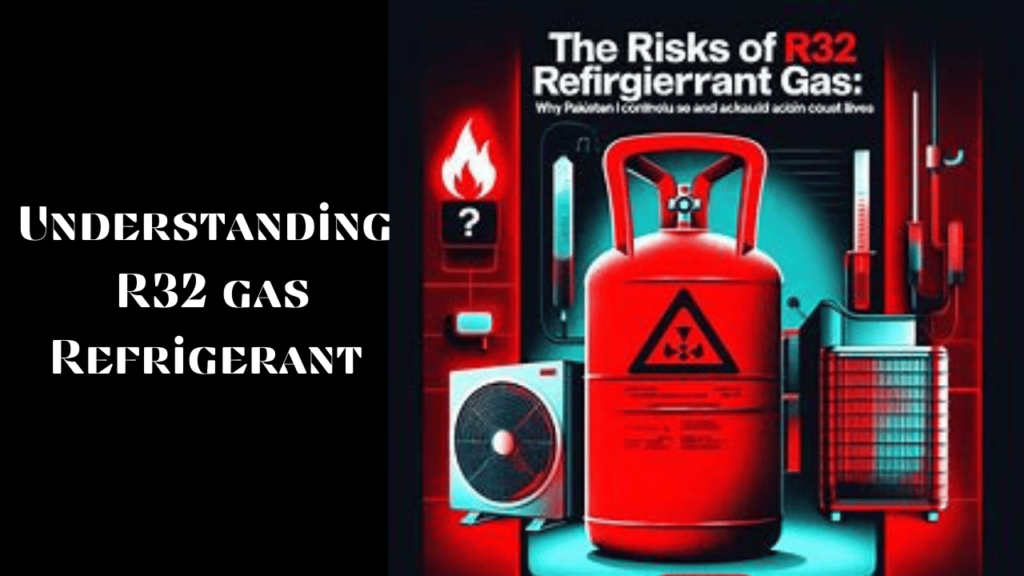Table of Contents
Introduction:

In recent years, R32 refrigerant has become a popular choice in air conditioning systems due to its lower global warming potential (GWP) compared to traditional refrigerants. However, recent incidents have highlighted serious safety concerns surrounding its use, especially in Pakistan. This blog will delve into the nature of R32 refrigerant, its benefits and drawbacks, and why its use in Pakistan is increasingly alarming.
Understanding R32 Refrigerant:

What is R32 Refrigerant?
R32, difluoromethane (CH2F2), is a refrigerant used in modern air conditioning systems. It is considered a more environmentally friendly alternative to older refrigerants due to its lower GWP and shorter atmospheric lifetime. This refrigerant has been gaining traction in the HVAC industry for its potential to reduce the environmental impact of cooling systems.
Chemical Properties and Composition:
R32 is a colorless, odorless gas classified as mildly flammable (A2L) by ASHRAE. It has a critical temperature of 78.2°C and a critical pressure of 5.808 MPa. Despite being categorized as mildly flammable, R32 is generally considered safe to handle and use, provided proper precautions are taken.
R32 in Comparison to Other Refrigerants:
Compared to other refrigerants like R410A, R32 offers several advantages. It has a GWP of 675, significantly lower than R410A GWP of 2088. This lower GWP makes R32 a more environmentally friendly option. Additionally, R32’s excellent thermodynamic properties result in higher energy efficiency and better performance in cooling systems.
Advantages of R32 Refrigerant:

High Energy Efficiency:
R32 refrigerant is renowned for its high energy efficiency. Its superior thermodynamic properties contribute to improved heat transfer and reduced energy consumption. Air conditioning systems using R32 often achieve higher Energy Star ratings, leading to lower operating costs and better performance.
Lower Environmental Impact:
One of the key benefits of R32 is its reduced environmental impact. With a GWP of 675, it is less harmful to the ozone layer compared to older refrigerants. Its shorter atmospheric lifetime further minimizes its potential to contribute to global warming.
Cost-Effective and Easy to Use:
R32 is also cost-effective due to its compatibility with various air conditioning designs and its straightforward manufacturing and recycling processes. Its single-component composition simplifies production, handling, and recycling, reducing maintenance and operational costs for both manufacturers and consumers.
Disadvantages of R32 Refrigerant:

Flammability and Safety Concerns:
The primary concern with R32 refrigerant is its flammability. As an A2L refrigerant, it has a low-level flame potential. While this may not pose significant risks in controlled environments, it can be dangerous in residential and commercial settings if not handled properly. Proper installation and maintenance are crucial to mitigating these risks.
Retrofitting and Compatibility Issues:
Retrofitting older air conditioning systems to use R32 can be challenging. Some systems may not be compatible due to differences in operating pressures and components. Consulting with a certified professional or the manufacturer is essential before attempting any retrofit.
The Karachi Incident: A Stark Warning:
Recently, Karachi witnessed a tragic incident involving R32 refrigerant. Late at night, an air conditioner inner unit exploded during a gas-refilling process in Liaquatabad No9, killing four people and injuring six others. The explosion, caused by a short circuit near the compressor, resulted in severe structural damage and casualties.
This incident underscores the potential dangers associated with R32, especially when not properly handled or maintained. The explosion highlights the need for stricter safety measures and regulations to prevent such tragedies in the future.
Why R32 Is Used and the Issues in Pakistan:
Why R32 Is Preferred?
Its environmental benefits and energy efficiency drive R32 adoption. As countries work towards reducing greenhouse gas emissions, R32 offers a viable alternative to more harmful refrigerants. However, its flammability poses a risk that must be carefully managed.
The Situation in Pakistan:
Despite its advantages, the use of R32 in Pakistan raises significant concerns. Many brands continue to use this refrigerant without adequate safety measures, putting lives at risk. The recent Karachi incident is a stark reminder of the potential dangers associated with R32. The lack of stringent regulations and enforcement in Pakistan exacerbates the problem, allowing brands to prioritize profits over safety.
How to Identify the Refrigerant in Your AC Unit:
To determine whether your air conditioner uses R32 refrigerant, check the unit’s specifications or label. Most modern systems will clearly state the type of refrigerant used. If you’re unsure, consult a certified HVAC technician for assistance.
R32 Refrigerant Pressure Chart:
The pressure of R32 refrigerant changes with the system temperature. Below is a simple chart that shows how R32 pressure corresponds to different temperatures:
| Temperature (°C) | Pressure (PSI) | Pressure (kPa) |
|---|---|---|
| -20 | 36 | 248 |
| -10 | 54 | 372 |
| 0 | 78 | 538 |
| 10 | 110 | 758 |
| 20 | 152 | 1048 |
| 30 | 205 | 1413 |
| 40 | 270 | 1862 |
| 50 | 352 | 2426 |
| 60 | 453 | 3124 |
Important Considerations:
- R32 Pressure Levels: R32 refrigerant operates under higher pressures than older refrigerants like R22. This makes it essential to have the right system design and to follow safety measures.
- Why It Matters: Knowing how R32 pressure varies with temperature is key for maintaining your system, troubleshooting issues, and ensuring that your HVAC system operates safely and efficiently.
Conclusion:
While R32 refrigerant offers several benefits, including lower environmental impact and improved energy efficiency, its flammability and safety concerns cannot be ignored. The recent incident in Karachi highlights the urgent need for better safety practices and regulations in Pakistan. As consumers, it’s essential to be aware of the risks and ensure that any air conditioning systems using R32 are properly maintained and installed.
Disclaimer: This blog aims to provide information on the potential risks and benefits associated with R32 refrigerant. Always consult with a certified professional for specific advice and safety guidelines.
FAQs:
What is R32 refrigerant?
R32, or difluoromethane, is a refrigerant used in air conditioning systems. It is known for its lower global warming potential (GWP) compared to older refrigerants like R410A, making it a more environmentally friendly option. R32 is a colorless, odorless gas that falls into the A2L classification, indicating it is mildly flammable.
What are the advantages of using R32 refrigerant?
R32 refrigerant offers several benefits:
High Energy Efficiency: R32 has superior thermodynamic properties that enhance heat transfer, reducing energy consumption and improving performance.
Lower Environmental Impact: With a GWP of 675, R32 is less harmful to the ozone layer compared to traditional refrigerants.
Cost-Effective: Its compatibility with various air conditioning systems and simplified manufacturing processes make R32 a cost-effective choice for both manufacturers and consumers.
What are the potential drawbacks of R32 refrigerant?
Despite its advantages, R32 has some potential drawbacks:
Flammability: Classified as an A2L refrigerant, R32 is mildly flammable. Proper installation and maintenance are crucial to minimize safety risks.
Retrofitting Issues: Older air conditioning systems may not be compatible with R32 due to differences in operating pressures and components. Retrofitting can be complex and may require professional assistance.
How can R32 refrigerant cause safety issues?
R32 flammability poses safety risks, particularly if the refrigerant is not handled or maintained correctly. Recent incidents, such as the explosion in Karachi, highlight the dangers associated with improper installation or maintenance of systems using R32. Ensuring proper safety measures and adherence to regulations is essential to prevent such incidents.
How can I identify if my air conditioner uses R32 refrigerant?
To determine if your air conditioner uses R32 refrigerant, check the unit specifications or label. Most modern air conditioning systems will indicate the type of refrigerant used. If the information is not readily available, consult a certified HVAC technician for accurate identification.
Is R32 refrigerant safe to use?
R32 refrigerant is generally considered safe when used by proper installation, maintenance, and safety guidelines. However, its mild flammability means that care must be taken to ensure the refrigerant is handled correctly and systems are properly maintained to mitigate any potential risks.
What steps can I take to ensure the safe use of R32 refrigerant in my air conditioning system?
To ensure safe use of R32 refrigerant:
Proper Installation: Have a certified HVAC professional install your air conditioning system to ensure it meets safety standards.
Regular Maintenance: Schedule regular maintenance checks to identify and address any potential issues with your system.
Adhere to Safety Guidelines: Follow all safety guidelines provided by the manufacturer and industry standards for handling and operating systems with R32 refrigerant.
What actions should be taken if an air conditioning unit using R32 refrigerant is involved in an accident?
In the event of an accident involving an air conditioning unit with R32 refrigerant, immediate steps should include:
Evacuate the Area: Ensure everyone is safely evacuated from the area to avoid exposure to potentially harmful fumes.
Contact Emergency Services: Call emergency services to address any immediate hazards or injuries.
Report the Incident: Notify relevant authorities and the manufacturer to investigate the cause and prevent future occurrences.
Are there regulations regarding the use of R32 refrigerant in Pakistan?
As of now, there are limited regulations specifically addressing the use of R32 refrigerant in Pakistan. However, industry standards and safety guidelines should be followed to ensure proper handling and installation. The lack of stringent regulations may pose risks, as highlighted by recent incidents, emphasizing the need for better oversight and enforcement.
What should consumers look for when purchasing air conditioning systems in Pakistan?
Consumers should prioritize the following when purchasing air conditioning systems in Pakistan:
Reputable Brands: Choose brands known for their adherence to safety and quality standards.
Certification: Ensure the system is certified for safety and performance by relevant authorities.
Safety Features: Look for systems with built-in safety features and compliance with industry standards to reduce risks associated with refrigerants like R32.
What is the HSN Code for R32 Gas?
The Harmonized System of Nomenclature (HSN) code for R32 refrigerant gas, commonly used in air conditioning systems, is 2903.39. This code falls under the broader category of fluorinated hydrocarbons, derivatives of hydrocarbons containing only fluorine.
Key Points:
HSN Code: 2903.39
Category: Fluorinated Hydrocarbons
Purpose: Used for customs and taxation purposes to classify products traded internationally.
This HSN code helps in identifying the product for tax calculation and regulatory purposes when importing or exporting R32 refrigerant gas. Always check with local authorities or customs for the most accurate and up-to-date information, as classifications can vary slightly by region.
What is the Cost of R32 Gas for a 1.5 Ton AC?
The cost of R32 refrigerant gas required for a 1.5-ton air conditioner depends on several factors, including the country of purchase, local market prices, and the amount of refrigerant needed.
On average, a 1.5-ton AC unit requires approximately 0.7 to 1.2 kg of R32 refrigerant. Given this, the cost can be estimated as follows:
India: ₹420 to ₹840, considering the price range of ₹600 to ₹700 per kg.
United States: $12.60 to $26.40, based on $18 to $22 per kg.
United Kingdom: £10.50 to £21.60, considering £15 to £18 per kg.
Australia: AUD 42 to AUD 84, based on AUD 60 to AUD 70 per kg.
These are approximate costs and can vary based on factors like local taxes, availability, and brand of the refrigerant
What is the price of R32 gas per Kg?
The price of R32 refrigerant gas varies significantly across different countries. Here are some general insights:
India: The price of R32 refrigerant typically ranges from ₹600 to ₹700 per kg
Australia: The cost is approximately AUD 60 to AUD 70 per kg.
United States: In the U.S., the price is around $8 to $10 per pound (roughly $18 to $22 per kg).
United Kingdom: The price in the UK is approximately £15 to £18 per kg.
These prices are influenced by factors such as import duties, local demand, and environmental regulations in each country. R32 is becoming increasingly popular due to its lower global warming potential (GWP) compared to other refrigerants like R410A, making it a more eco-friendly option.
What are the key differences between R32 and R410A refrigerants?
R32 is a single component refrigerant with a lower global warming potential (GWP) of 675, whereas R410A is a blend of two refrigerants (R32 and R125) with a higher GWP of 2088. R32 is also more energy-efficient and has better thermodynamic properties compared to R410A.
Which refrigerant is more environmentally friendly: R32 or R410A?
R32 is more environmentally friendly due to its significantly lower GWP of 675, compared to R410A GWP of 2088. This makes R32 a better choice for reducing the environmental impact of cooling systems.
Why is R32 considered more energy-efficient than R410A?
R32 has superior thermodynamic properties, which enhance heat transfer and reduce energy consumption. This results in higher energy efficiency for air conditioning systems using R32 compared to those using R410A.
What should I consider when choosing between R32 and R410A for my air conditioning system?
When choosing between R32 and R410A, consider factors like environmental impact, energy efficiency, safety (flammability), cost, and compatibility with your current system. Consulting with an HVAC professional can help you make the best decision for your specific needs.
Which refrigerant is more commonly used in newer air conditioning systems, R32 or R410A?
R32 is increasingly being adopted in newer air conditioning systems due to its lower environmental impact and higher energy efficiency. However, R410A is still widely used in many existing systems.
Is R32 safer to use than R410A?
R32 is classified as mildly flammable (A2L), whereas R410A is non-flammable. While R410A poses no flammability risks, R32 flammability requires careful handling and proper safety measures during installation and maintenance.
Which Gas is Safe R32 or R410?
R32: R32 is a mildly flammable refrigerant (classified as A2L), meaning it poses some fire risk if not handled properly. However, it has a lower Global Warming Potential (GWP of 675), making it a more environmentally friendly option.
R410A: R410A, on the other hand, is non-flammable (classified as A1) and does not pose a fire risk, which makes it safer in terms of flammability. However, it has a higher GWP of 2088, contributing more to global warming.
Which to Choose? R32 is safer for the environment but requires strict safety measures, while R410A is safer in terms of flammability but has a higher environmental impact. The choice depends on whether your priority is environmental sustainability or flammability safety.
Which Gas is Better, R32 or R410A?
e choice between R32 and R410A depends on your priorities:
R32: This refrigerant is better for the environment due to its lower Global Warming Potential (GWP of 675) and higher energy efficiency. However, it is mildly flammable, so it requires careful handling and proper installation.
R410A: While R410A is non-flammable and safer to handle in terms of fire risk, it has a higher GWP (2088), making it less environmentally friendly. It is also less efficient in terms of energy consumption compared to R32.
Verdict: R32 is preferable if you prioritize environmental sustainability and energy efficiency, but R410A is safer in terms of flammability.
Does R32 Gas Smell?
No, R32 refrigerant is an odorless gas. It does not have a distinct smell, so leaks can be difficult to detect without proper equipment. Due to its mild flammability, it’s important to ensure that any system using R32 is well-maintained and checked regularly by professionals to avoid potential hazards.
Is R32 gas harmful to humans?
R32 gas, or difluoromethane, is generally considered to have a low toxicity when used in proper concentrations and under normal operating conditions. However, it can be harmful if inhaled in large quantities or if it comes into contact with skin or eyes. In confined spaces, high concentrations of R32 can displace oxygen and pose asphyxiation risks. Always handle it with care and follow safety guidelines to minimize exposure.
Which gas is better for a split AC: R22, R410A, or R32?
R22: An older refrigerant with a high GWP and ozone-depleting properties. It is being phased out due to environmental concerns and is less efficient compared to newer options.
R410A: A more modern refrigerant with a lower GWP than R22, but still relatively high compared to R32. It does not deplete the ozone layer but is less efficient in terms of energy compared to R32.
R32: The most eco-friendly option among the three, with a lower GWP and better energy efficiency. It is also more efficient in transferring heat, which can lead to better performance and lower energy consumption.
Overall, R32 is generally considered the better choice for new split AC systems due to its lower environmental impact and improved efficiency.
Is R32 gas eco-friendly?
R32 is considered more eco-friendly compared to some older refrigerants like R22. It has a lower Global Warming Potential (GWP) of about 675, which is significantly lower than R410A (with a GWP of about 2088) and R22 (with a GWP of about 1810). This means that R32 contributes less to global warming. It also has better energy efficiency, which can further reduce its overall environmental impact.
What is the full name of R32 gas?
R32 gas is also known as difluoromethane. It is a refrigerant used in air conditioning and refrigeration systems.
What is the price of R410A gas?
The price of R32 refrigerant gas varies significantly across different countries. Here are some general insights:
India: The price of R32 refrigerant typically ranges from ₹600 to ₹700 per kg
Australia: The cost is approximately AUD 60 to AUD 70 per kg.
United States: In the U.S., the price is around $8 to $10 per pound (roughly $18 to $22 per kg).
United Kingdom: The price in the UK is approximately £15 to £18 per kg.
For the most accurate and up-to-date pricing, it’s best to check with local refrigerant suppliers or distributors.
What is the price of air conditioning gas?
The price of air conditioning gas (refrigerant) varies depending on the type of refrigerant, the region, and the supplier. Here are some general price ranges:
R22: Often more expensive due to its phase-out and scarcity. Prices can range from $50 to $200 per pound, depending on availability.
R410A: Typically costs between $50 and $150 per pound. Prices may vary based on market conditions and supplier.
R32: Generally more affordable than R22 and R410A, with prices ranging from $30 to $80 per pound.
For the most accurate and up-to-date pricing, it’s best to check with local refrigerant suppliers or distributors.
What are the types of air conditioner gas (refrigerants)?
Here are the common types of refrigerants used in air conditioners:
R22 (Chlorodifluoromethane):
Characteristics: An HCFC refrigerant used in older systems.
Environmental Impact: Contributes to ozone depletion; being phased out.
R410A (Difluoromethane and Pentafluoroethane):
Characteristics: An HFC blend that offers better efficiency and does not deplete the ozone layer.
Environmental Impact: Higher Global Warming Potential (GWP) compared to newer refrigerants; still in use but gradually being replaced.
R32 (Difluoromethane):
Characteristics: A single-component HFC with lower GWP and higher energy efficiency.
Environmental Impact: More eco-friendly with a lower GWP; increasingly used in new systems.
R134a (1,1,1,2-Tetrafluoroethane):
Characteristics: An HFC used in automotive and some commercial air conditioning systems.
Environmental Impact: Higher GWP; gradually being phased out in favor of alternatives with lower GWP.
R290 (Propane):
Characteristics: A natural refrigerant with very low GWP and high efficiency.
Environmental Impact: Environmentally friendly but highly flammable; used in some applications, particularly in Europe.
R744 (Carbon Dioxide, CO2):
Characteristics: A natural refrigerant with very low GWP and excellent thermodynamic properties.
Environmental Impact: Minimal impact on global warming; gaining popularity in certain applications.
What is the standing pressure of R32 gas?
The standing pressure of R32 gas, also known as difluoromethane, can vary depending on the temperature. Generally, at standard ambient temperatures, the pressures are approximately:
At 20°C (68°F): The standing pressure of R32 is about 5.8 to 6.0 bar (approximately 84 to 87 psi).
At 30°C (86°F): The standing pressure of R32 is about 9.2 to 9.4 bar (approximately 133 to 136 psi).
These values are approximate and can vary slightly based on specific conditions and calibration. Always refer to the manufacturer’s specifications for precise measurements and safety guidelines.
What is the standing pressure of R410A gas?
The standing pressure of R410A gas varies with temperature. Generally:
At 20°C (68°F): The standing pressure is about 11.0 to 11.5 bar (approximately 160 to 165 psi).
At 30°C (86°F): The standing pressure is about 15.0 to 15.5 bar (approximately 220 to 225 psi).
These values are approximate and can vary based on specific conditions. Always consult the manufacturers specifications for precise measurements.
Where can I find a refrigeration gas pressure chart?
A refrigeration gas pressure chart provides pressure values for different refrigerants at various temperatures. You can typically find these charts in:
Refrigeration and HVAC Manuals: Manufacturer manuals and industry guides often include pressure charts.
Online Resources: Websites dedicated to HVAC and refrigeration provide downloadable charts.
Professional Training Materials: Training courses and technical guides for HVAC technicians often include these charts.
Ensure that the chart is specific to the refrigerant you are using, as pressure values differ among refrigerants.
What is the standing pressure of R290 gas?
R290, also known as propane, has varying standing pressures depending on the temperature:
At 20°C (68°F): The standing pressure of R290 is about 8.0 bar (approximately 115 psi).
At 30°C (86°F): The standing pressure of R290 is about 11.0 bar (approximately 160 psi).
These values are approximate and can vary based on specific conditions. Always refer to the manufacturer’s specifications for accurate measurements and safety information.
What is the high-pressure reading for an R410A AC unit?
For an air conditioning unit using R410A refrigerant, the high-pressure readings can vary depending on the system’s operating conditions and ambient temperature. Generally:
At 25°C (77°F): The high-pressure reading is typically between 18.0 and 20.0 bar (approximately 260 to 290 psi).
At 35°C (95°F): The high-pressure reading can be between 22.0 and 24.0 bar (approximately 320 to 350 psi).
These values are approximate and can vary based on specific system design and operating conditions. Always refer to the manufacturer’s specifications and service guidelines for accurate pressure readings and maintenance procedures.
What is the best refrigerant for air conditioning?
The best refrigerant for air conditioning depends on various factors such as environmental impact, efficiency, and system compatibility. Here are some commonly used refrigerants and their benefits:
R32 (Difluoromethane):
Pros: Low Global Warming Potential (GWP), high energy efficiency, and better heat transfer performance.
Cons: Slightly flammable, requiring careful handling.
Best For: Newer AC systems focused on environmental impact and efficiency.
R410A (Difluoromethane and Pentafluoroethane):
Pros: No ozone depletion potential, good performance, and widely used.
Cons: Higher GWP compared to R32, contributing to global warming.
Best For: Existing AC systems and areas where R32 is not yet common.
R290 (Propane):
Pros: Very low GWP, high efficiency, and environmentally friendly.
Cons: Highly flammable, which requires proper handling and safety measures.
Best For: Applications with stringent environmental regulations and where safety precautions are in place.
R134a (1,1,1,2-Tetrafluoroethane):
Pros: Good performance in various applications, including automotive AC systems.
Cons: Higher GWP, leading to a gradual phase-out in favor of lower-GWP alternatives.
Best For: Automotive and older AC systems where newer refrigerants are not yet practical.
Choosing the best refrigerant will depend on your specific needs, regulatory requirements, and environmental goals.











Well define hazardous of r32 must read . advantage are mandatory but not more then life
I completely agree with you—this is serious business. While R32 has its advantages, nothing is more important than safety. It’s crucial to understand the risks and take all necessary precautions when dealing with it. No benefit is worth putting lives at risk. Thanks for reminding us all to keep safety first.
Handling A2L, A2 refrigerant materials must be the same as the safety guidelines, when using A3 refrigerant materials.
Absolutely, handling A2L and A2 refrigerants should adhere to the same safety guidelines as when using A3 refrigerants. Ensuring safety and following proper procedures is key for all these materials.
Using A2 and A2 refrigerants in AC units must be based on the work stages as when using A3 refrigerant.
Absolutely, using A2 and A2L refrigerants should follow similar work stages as with A3 refrigerants to ensure safety. Proper handling, leak detection, and adherence to safety protocols are crucial regardless of the refrigerant type to maintain safe and efficient operation of AC units.
You’ve done an impressive work on your website in covering the topic. I am working on content about Cosmetic Treatment and thought you might like to check out et me what you think.
Thanks for Comment